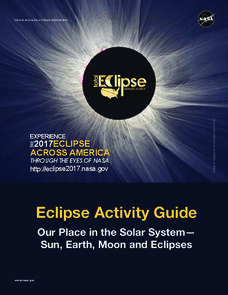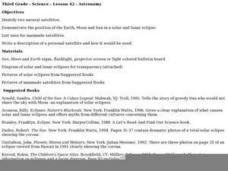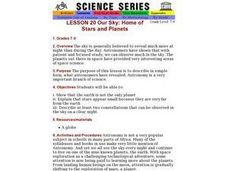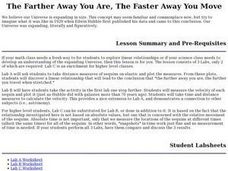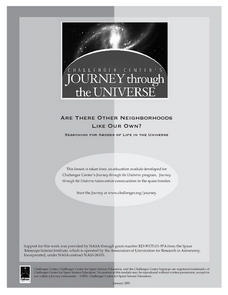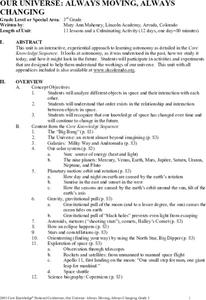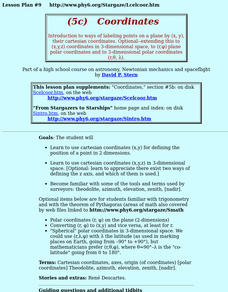NASA
Eclipse Activity Guide
Ever made solar s'mores? Or recreated the solar system using peanuts? Astronomers young and old investigate all things solar using a variety of activities. Explore how the sun works, types of light it emits, and methods of charting the...
It's About Time
The Sun and Its Effects on Your Community
Why is the sun round? Examine this question, and others, with your pupils while teaching them how to live in a more earth-friendly environment. Pupils explore Sun composition and discuss how solar wind, sunspots, and solar energy affects...
Weber State University
The Sun and the Seasons
Why is there more daylight in June than in December if you live above the equator? How does the angle of sunlight shift throughout the year? Answer these questions and more with an interactive article about the sun, its path through the...
Curated OER
Celestial Photography
Students practice photographic skills and gain an awareness of photography as a scientific tool.
Curated OER
Seeing The Sun In A New Light
Students examine the observation of "coronal holes," by x-rays, also about related fast streams and moderate magnetic storms that recur at 27 day intervals. They study NASA'S great observatories.
Curated OER
Science - Lesson 42 - Astronomy
Third graders demonstrate the position of the Earth, Moon, and Sun in a solar and lunar eclipse. They list uses for manmade satellites and write a description of how a satellite would be use.
Curated OER
Our Sky: Home of Stars and Planets
Young scholars discover that astronomy is a branch of science that includes the study of planets, stars, and constellations.
Curated OER
Using Star Charts and Maps
Students study star charts and describe locations of objects. In this scientific models lesson students use coordinates and identify characteristics.
Curated OER
Earth and Beyond!
Pupils investigate one or more of the following topics and develop a plan for the future regarding it: global warming, lunar exploration, space travel, Mars exploration, or terraforming. They disucss the audio files and the video that...
Curated OER
Exploring the Planets
Sixth graders explore the planets through an interactive web site. In this astronomy based lesson, 6th graders compare planets, explore comets, and discover planet facts through a variety of activities provided by the Smithsonian Museum.
Curated OER
The Farther Away You Are, The Faster Away You Move
Students explore linear relationships. The lesson uses science to develop an understanding of the expanding Universe. There are 3 Labs, only 2 of which are required. Lab C is an enrichment for higher level classes.
Curated OER
The Night Sky
Third graders develop questions they have about the solar system. After being read a book, they view and discuss different constellations in the sky. In groups, they are given a piece of butcher paper and glow in the dark crayons in...
Curated OER
Sun and Moon Poetry Baskets
Pupils write Sun and Moon poetry. For this poetry lesson, students research the sun and the moon. They write poetry and create two class baskets for descriptive words about each.
Curated OER
Seeing Interference Fringes with a Telescope
High schoolers construct an interferometer using a simple telescope. In this physics lesson, students explain how light waves create the fringe patterns. They observe patterns made by different objects in the sky and compare them.
Curated OER
Earth, Moon, Mars Balloons
Middle schoolers demonstrate size and orbits of Earth, Moon, and Mars. In this space science lesson plan, students will use balloons to show how the size and distance between the planets and satellite compare.
Curated OER
Are There Other Neighborhoods Like Our Own?
Students investigate the possibility of life existing on other planets. They conduct research using a variety of resources. The lesson includes an overview that is used for classroom discussion practices. They tell the teacher how to...
Curated OER
A Model of the Sun's interior
Young scholars create a three-dimensional model of the sun. In this solar system lesson, students design a scale model of the sun using plasticine.
Curated OER
Our Solar System to Scale
Students calculate the diameter of planets and their relative distances. In this space science activity, students discover how small or big the planets are in comparison to each other. Students use cross multiplying fractions to...
Curated OER
Studying Shadows
Students measure shadows and explore the altitude of the sun. In this sun instructional activity students will graph the length of shadows and solar altitude against time.
Curated OER
Constellation Projections
Students draw constellations. In this astronomy lesson, students create constellations from star groupings projected on a chalk board. Students connect the "stars" to create a pattern on the board. Student can create new groupings of...
Curated OER
Make it Yourself Constellation Finder
Students identify constellations with and without a constellation finder. In this creating constellations lesson students construct a constellation finder to help them to identify the constellations.
Curated OER
Project SETI.
Tenth graders study how to search for life in outer space and make use of the 40-foot radio telescope at Greenbank, West Virginia. Request that the telescope be pointed at a particular location and time and receive data back from it...
Curated OER
Our Universe: Always Moving, Always Changing
Students explore the main concepts of astronomy through the eleven lessons of this unit. The past, present, and future methods of studying the science are examined in this unit.
Curated OER
Coordinates
High schoolers use cartesian coordinates (x,y,z) in 3-dimensional space. [Optional: appreciate there exist two ways of defining the z axis, and which of them is used.] They become familiar with the tools and terms used by surveyors.


